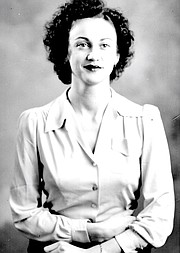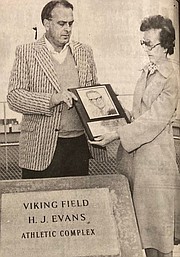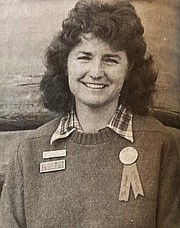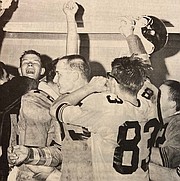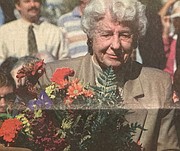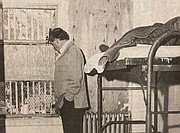HUCKLEBERRIES: A defining moment in Wallace brothel history
Facing political pressure, a half-century ago, the brothels of Wallace closed for the first time ever.
And the town didn’t like it.
Dolores Arnold, the madam who had operated the Lux and Luxette for 30 years, told the Coeur d’Alene Press at the time that townspeople were “furious over the shutdown of the thriving redlight district.”
And she predicted that rape and venereal disease would increase as a result.
City Attorney Dennis Wheeler would only say that the voluntary action by the five remaining cathouses — Oasis, A&I Rooms, Sahara and Arnold’s two places — was “permanent.”
But “permanent” in the rugged Wallace of the mining days meant something different than Webster’s definition: “Lasting or intended to last or remain unchanged indefinitely.”
The “permanent” ban on Wallace’s houses remained for a weekend or maybe a week, according to Heather Branstetter, a Wallace councilwoman who wrote the definitive history on the sex trade in her town: “Selling Sex in the Silver Valley: A Business Doing Pleasure (2017).”
“It certainly changed how they did business,” Heather told Huckleberries last week. “They became more discreet. The (outdoor) signs came down, and they never went back up.”
A key factor in the shutdowns was a 1972 change in state law. The revision made prostitution illegal in Idaho and removed authority to control it from Class 2 towns, like Wallace.
The closures occurred shortly before the publication of a series of scathing articles in the Idaho Statesman by Boise attorney Stanley Crow. The crusading Republican claimed Democratic Gov. Cecil Andrus was going easy on gambling and prostitution in Wallace and North Idaho in exchange for a $25,000 campaign donation.
Andrus denied the accusation, according to the New York Times. But the madams padlocked their places before Crow’s articles aired.
Arnold, who was celebrated for generosity in her adopted town, was correct in stating that the town didn’t support the closure.
In a poll, conducted by picking random names from a phone book, the United Press International reported seven of 10 Wallace residents opposed the move, two backed it, and one was undecided.
“I think they should stay open,” said Mrs. Richard A. Anderson, who had lived across the street from one of the brothels since 1939. “They don’t bother me. I think it’s foolish to close them because we’ve never had any rape here, and they spend a lot of money here.”
The benevolence of the Wallace bordellos was captured in the first stanza of “Hook Houses” by poet Linda L. Beeman, a Wallace native: “Every 12-year-old charged/with selling something to benefit anything/knew like “The Lord’s Prayer”/the first step you climbed led to brothel doors.”
Outsiders mourned the shutdown, too. Later, in the fall of 1973, according to the Times, students at the football game between the University of Idaho and Weber State at Moscow unfurled a 5-by-40-foot banner at halftime pleading: “Governor Andrus – Give Wallace Back its Houses.”
Puppy love
In a recent column, Huckleberries told you about the opening of Harold Evans sports complex at Coeur d’Alene High (Sept. 15, 1978). But it didn’t tell you much about Principal Evans, the man behind the name who guided CHS from 1945 to 1966 (not 1954-66 as previously reported). A follow-up Press story provided more information about him: “He was remembered for taking in stray puppies and temporarily housing them in his file cabinet until they were claimed by the students they had disobediently followed to school.” And “He spent more time in the classroom, hallways and gymnasium than in his office, hungering to be in direct contact with the students he loved and devoted 55 years of his life to.” Vik coaching great Elmer Jordan and the Quarterback Club led the successful campaign to name the sports complex after the worthy educator.
Remembering Lee
On Oct. 1, 1988, Lee Caires was featured in a Press mini-biography that revealed her likes and dislikes. A substitute teacher, tutor and volunteer extraordinaire, Lee listed her hobbies as outdoor sports, baking, reading and activities with her four children. Her pet peeve? “Motorists who don’t use their turn signals.” In 1992, she remained behind when her husband, Steve, was hired as vice principal of Frontier Junior High in Moses Lake, Wash. She waited until her youngest kids, the twins, graduated from CHS. And then joined her husband at Moses Lake in 1994 as a teacher. On Feb. 2, 1996, she died defending her fifth-grade algebra class from a 14-year-old gunman. Two students died with her. The coward who killed them is still in prison. All of which makes the “goals and dreams” part of the mini-bio sadder: “Seeing my children grow up healthy, happy and productive.” Leona “Lee” Caires is gone too soon but not forgotten.
Huckleberries
• Poet’s Corner: Within each ugly cloud of gray/a silver lining’s found, they say,/but they neglect to caution you/that lightning’s also found there, too – The Bard of Sherman Avenue (“Silver Lining and Zapppp”).
• By the Way – Heather Branstetter is writing a follow-up book to “Selling Sex in the Silver Valley.” It will focus on the end of prostitution in Wallace (1990-91) and the FBI’s "Black Sunday" gambling raid of Silver Valley bars on June 23, 1991. Heather credits a bad economy, AIDS and, possibly, a lower variety of madams for ending prostitution.
• Trivia — And the answer is — 33. The Question? How many games had the powerhouse Immaculate Heart of Mary Academy football team from Coeur d’Alene won in a row before it lost to Lakeland High? The Lakeland Hawks blanked the Panthers 21-0 on rain-slicked Person Field on Sept. 21, 1968.
• Breaking Black — After 10 years of celebration — and sporadic turbulence — the Coeur d’Alene Regatta Association revealed that the 1968 Diamond Cup Hydroplane races finished $581 in the black. And that was significant because the 1968 races were to be the last ones of the original set. Organizers at the time described the future of the races as “unsettled.”
• Did You Know … that the Department of Lands building in Coeur d’Alene is named after Louise Shadduck, the first female to ever serve in a state cabinet? Pioneer daughter. Press reporter. Congressional aide. Author. She did it all. Earth to Newcomer — You can learn much about your new home by reading Mike Bullard’s swell biography: “Lioness of Idaho: Louise Shadduck and the Politics of Polite.”
Parting shot
No matter how crowded the current Kootenai County Jail gets, it’ll never approach the sorry condition of the old three-story one on the courthouse campus. A judge eventually declared the basement jail unfit for humans. And then, for years, the county shipped prisoners to Wallace. Now, onward. On Sept. 28, 1978, during a quarterly tour, Commissioner Douglas Frymire got fussy about the messy array of paper cups and food wrappers lining a gloomy cell in the women’s area. If they want food, Frymire fumed, the inmates should be required to clean their cells. From a nearby cell, a female replied, “We don’t get paid for cleaning up cells.” Then, another inmate added: “Get us a television set up here.” And that’s where things stood until 1987 when the county opened the current jail on Government Way.
• • •
D.F. “Dave” Oliveria can be contacted at dfo@cdapress.com.









